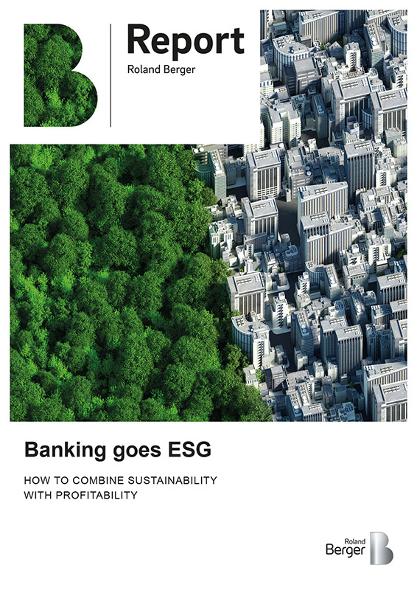Roland Berger, Ortec Finance and M2Mobi, asses key trends in HNWI needs and how private bankers can address these in a future-proof hybrid offering


ESG in banking: Combining sustainability with profitability
How ESG initiatives can boost a bank’s bottom line
ESG has gained increasing significance for financial institutions over the years as the pressure mounts on them to show their commitment towards sustainable business. Roland Berger’s report, “Banking goes ESG: How to combine sustainability with profitability,” shows how the E of ESG is proving to be lucrative not just to banks but their stakeholders as well.

"While it is clear that banks have a financial interest in pushing ESG practices, the path to implementing them remains a challenge."
Banks and ESG: A winning combination
While the importance of sustainability is obvious on a broader level, green initiatives enable banks to achieve a unique selling point (USP) and thereby set themselves apart from their competitors.
As global financial leaders, banks are uniquely situated to facilitate and accelerate a wider transition to a more sustainable economy and society by channeling financing streams accordingly. For truly green banking, external policies are put in place that clients and investors must adhere to. These policies help bring sustainability into all surrounding avenues and communities that are impacted by banking.
ESG ratings and initiatives are growing in importance
ESG ratings demonstrate a company’s long-term sustainability goals and strategies. They help differentiate between companies that are taking real, tangible steps toward reaching the world’s net zero carbon emissions goal and businesses that are “greenwashing” (i.e. cultivating a public appearance of sustainability without actually being sustainable).
According to an ESG data analysis by Roland Berger that evaluated the practices and performance of European banks from 2002-2020, the overall importance of ESG initiatives rose by 93 points (+79%) over the past two decades. The social criteria score (how a company treats its employees and clients) rose by 30 points (+70%) and governance (how a company polices itself) rose by 16 points (+30%). The environmental score (a company’s contribution to mitigating climate change) saw the largest increase: 47 points (+180%). A separate study that analyzed the return on equity (ROE) of over 200 banks in an eleven-year period found that E and G policies actually led to higher profitability, while S policies negatively impacted short-term profits.
The bigger the better
Roland Berger’s study revealed a strong correlation between a bank’s size and its ESG performance: the bigger the bank, the higher the ESG score. Larger banking groups tend to have more funds and more leverage to develop into a more sustainable future. Therefore, they may rank investing in sustainability into measures more highly in importance than their smaller competitors.
Transitioning from “think” to “act”
Given the societal and economic stakes involved, bank executives might wonder what steps they can take to improve their ESG scores and give themselves a competitive edge. Roland Berger has defined five steps to help banks amplify the effect of ESG measures both within the organization and in society as a whole – all while generating positive economic outcomes.
Firstly, banks must develop a structured approach that delivers a balanced set of effective initiatives tailored to their own specific needs. The initiative must come from the top and cascade down through the middle management to the rest of the workforce.
Steps to improve ESG initiatives
- Top executives should define the level of ambition for their ESG strategy and set short, medium, and long-term sustainability targets. At the same time, executives should also identify the current strengths and weaknesses of the bank to better assess when and how targets may be reached.
- The bank's leadership must be inspired to further feed the set of initiatives to take.
- An action plan with clear steps and a link to the ultimate goals should be drawn up and handed out to all involved.
This structured approach to strengthening ESG-related practices gives banks a clearly defined template to implement these strategies. Banks should map out their actions on a standard quadrant matrix to highlight which projects to execute first.
See Roland Berger’s report, “Banking goes ESG: How to combine sustainability with profitability,” to discover more about sustainable finance and the positive impact of ESG initiatives in financial services.
Register now to download the full PDF on combining sustainability and profitability and get regular insights into service topics.


![Change in banks' ESG performance, Refinitiv data [2002-2020]](https://img.rolandberger.com/content_assets/content_images/captions/roland_berger_ins_836_esg_in_finance_gt_01_image_caption_none.jpg?v=770441)
![Impact of sizable ESG initiatives on banks' ROE [2002-2020]](https://img.rolandberger.com/content_assets/content_images/captions/roland_berger_ins_836_esg_in_finance_gt_1_image_caption_none.jpg?v=770441)







